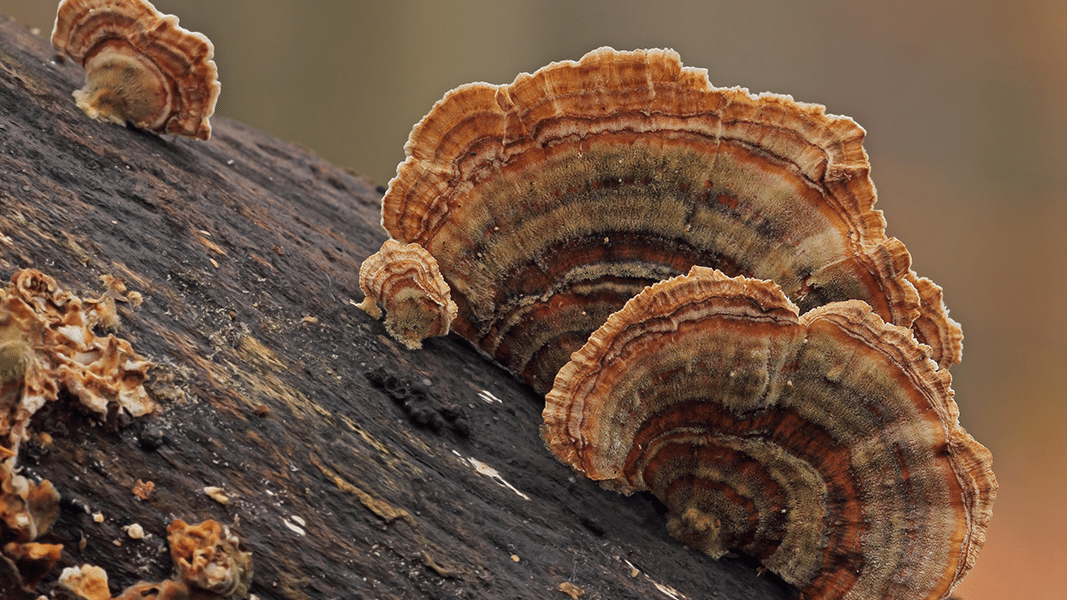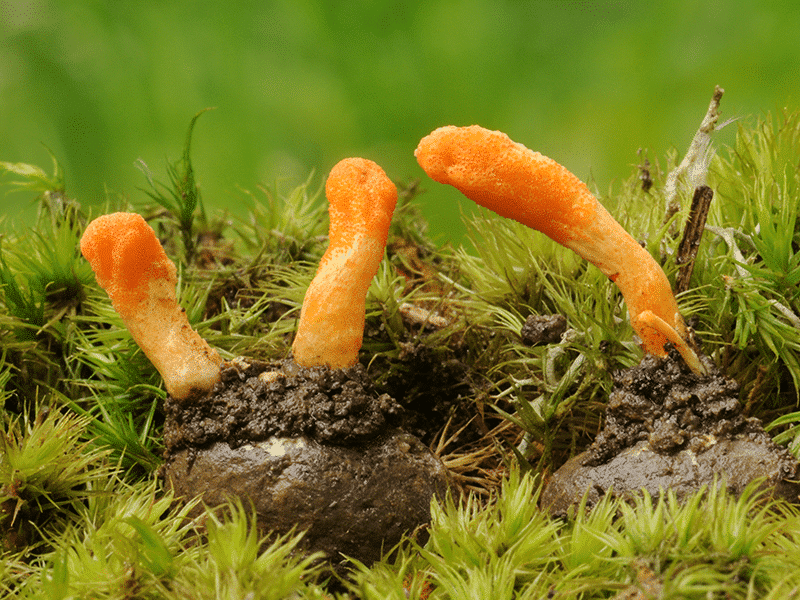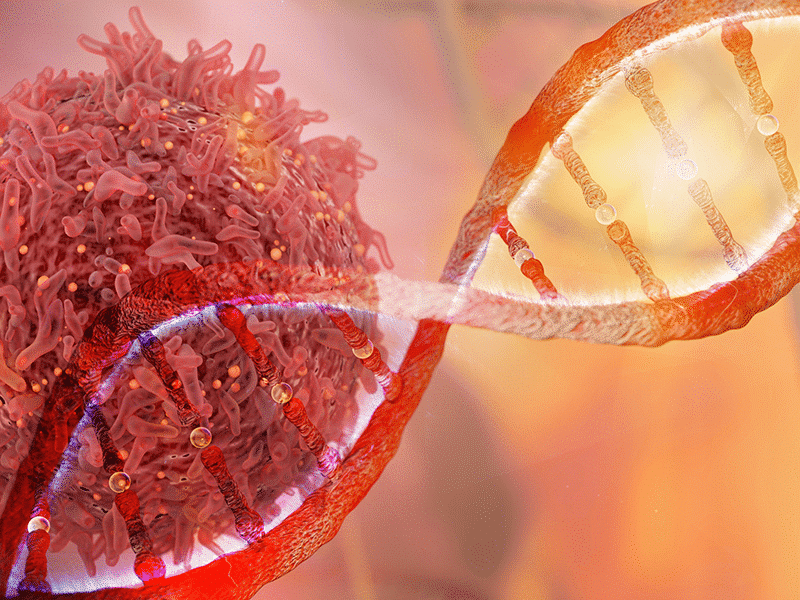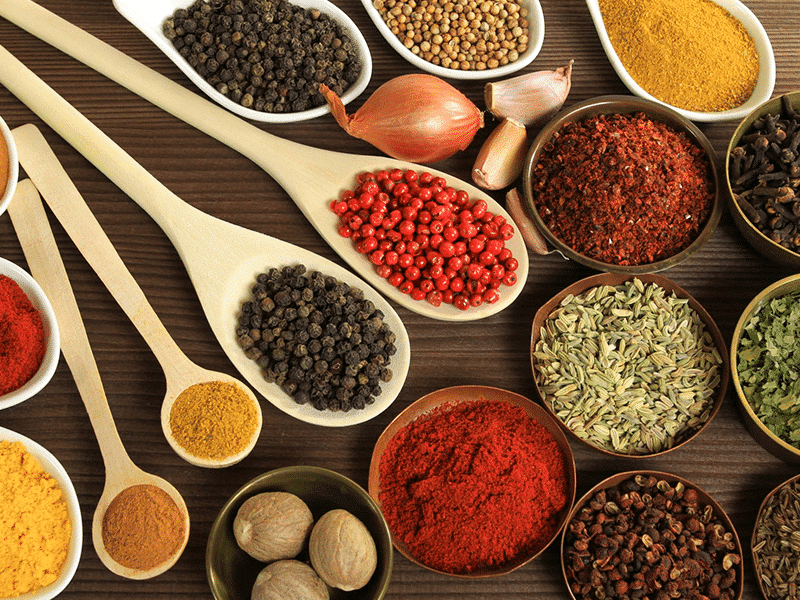Medicinal mushrooms — also called functional mushrooms — have been used traditionally for thousands of years as powerful healers to promote well-being and longevity. These mushrooms can help strengthen your immune system, lower inflammation, prevent disease, sharpen your mind, give you more energy, calm your nervous system, help you sleep better at night, and potentially even fight cancer.

Mushrooms have astonishing powers. Not only do mushrooms help us stay healthy as humans, but they play an instrumental role in the health of the planet. Mushrooms have been shown to excrete enzymes that break down the hydrocarbon bonds in plastic, and therefore can help clean toxins from the environment and the soil, a process known as mycoremediation.
Walk through any forest and you’ll probably see a mushroom or two growing under a tree or on a log — but the largest part of the fungi kingdom is actually hidden from our sight. Those beautiful mushrooms you see peeking out from the dirt are connected to an intricate network of underground roots called “mycelium.”
Arguably one of the most important substances on this planet, the mycelium of the mushroom kingdom lives underground, weaving its way throughout the root systems of every forest on Earth. These roots span for miles around the globe and are responsible for not only delivering nutrients to mushrooms and surrounding trees and plants but also for cleaning the soil and decomposing toxins and dead trees throughout the forest.
The mycelium is akin to the neurological network of the forest — mushroom expert Paul Stamets, author of Mycelium Running, refers to mycelium as the Earth’s “natural Internet.” This mushroom mycelium is connected to the root systems of trees and other plants, and they trade nutrients with one another.
Mushroom mycelium looks like tiny white threads — you might be able to find some just by going out into the forest and digging your hand into the woodchips under your feet. If you see tiny white strands running through the soil, you’ve found mycelium.
The Fruiting Body
The fruiting body is the part you likely think of when you imagine a mushroom — it’s the part that sprouts up from the ground, and it’s the “meaty” part of the mushroom we cook and eat. When you buy mushrooms at the grocery store, what you’re buying is the fruiting body. The fruiting body is made of condensed mycelium — it’s the reproductive structure of the mycelium. The fruiting body of the mushroom contains medicinal compounds called beta-glucans, which are naturally occurring polysaccharides. These are the compounds known for being able to modulate the immune system, and they are responsible for many of the healing properties of the mushrooms.
According to Professor Solomon P. Wasser, researcher at the University of Haifa and editor in chief of the International Journal of Medicinal Mushrooms, there are at least 650 species of mushrooms that are considered medicinal.
In The Rebel’s Apothecary, I focus on seven of the most potent medicinal mushrooms, each with specific therapeutic attributes:
- Chaga (Inonotus obliquus)
- Reishi (Ganoderma lucidum, Ganoderma tsugae)
- Lion’s mane (Hericium erinaceus)
- Cordyceps (Cordyceps sinensis, Cordyceps militaris)
- Maitake (Grifola frondosa)
- Shiitake (Lentinula edodes)
- Turkey tail (Trametes versicolor)
A lot of research has been done on these mushrooms — with promising results for both everyday wellness concerns and serious conditions like cancer. And all of these mushrooms are completely legal – unlike “psychedelic” psilocybin mushrooms, which also have remarkable therapeutic properties of their own, as I discuss in my book.
The Medicine Inside the Mushrooms
A “medicinal mushroom” is any mushroom that is safe for human consumption and has medicinal or health-enhancing properties; these include:
- Balancing the immune system
- Increasing energy and focus
- Calming the nervous system
- Soothing inflammation
- Providing antioxidants
- Exhibiting neuroprotective and neuroregenerative properties
- Stabilizing blood sugar
- Fighting cancer
Some medicinal mushrooms are great culinary mushrooms, too — meaning you can cook and eat them, just as you would with the mushrooms you buy at the grocery store.
So what exactly are the compounds inside mushrooms that have proven to be so medicinal? Although each kind of medicinal mushroom has its own unique chemical makeup, they all contain types of polysaccharides known as beta-glucans, which have immune-modulating and antitumoral properties. Medicinal mushrooms also contain compounds called triterpenes, metabolites, and enzymes — all of which contribute to the power of mushrooms to support the immune system and nervous system, lower inflammation, and contribute to our energy, focus, and vitality.
In addition, each mushroom contains its own active medicinal compounds. For instance, turkey tail mushrooms contain a polysaccharide called PSK, cordyceps mushroom contains cordycepin, reishi contains triterpenes called ganoderic acids, and wild-harvested chaga contains powerful compounds called betulin and betulinic acid. Each mushroom brings us a unique medicine.
“Mushrooms are rock stars for our immune systems, but they support other areas of the body, too — like the nervous system, liver, cardiovascular system and more. They are more normalizing than stimulating — you can think of them as gentle immune tonics,” says Aviva Romm, MD, an integrative physician, midwife, and herbalist who uses medicinal mushrooms in her practice.
Extracting Medicine from Mushrooms
Medicinal mushrooms contain some compounds that can be extracted with water (beta-glucans and enzymes) and some that need to be extracted in alcohol (triterpenes). While each process can bring out beneficial compounds, both are needed to get the full array of medicine out of most mushrooms. When mushroom products are extracted for supplements, ideally they should go through a double-extraction process (usually in both hot water and alcohol) in order to extract all of the most beneficial compounds.
Although there are some mushroom extracts and supplements on the market that are double-extracted, others aren’t — so it’s worth checking with the company or mushroom grower you’re purchasing mushroom extracts from to make sure the product you’re buying offers as many medicinal benefits as possible.
When you start to dip your toe into the medicinal mushroom world, you’ll see a vast array of mushroom products available. Some of the ways to consume medicinal mushrooms are:
- Tinctures
- Extracts
- Powders
- Capsules
- Dried mushrooms
- Fresh mushrooms
- Teas
- Mushrooms infused into foods or beverages
You can get great-quality medicinal mushroom products at health food stores and online — but do your research to make sure the product has been double-extracted so you get as many healing benefits as possible.
Mushrooms have a tough cell wall called chitin that our digestive systems can’t break down, and in order to release the nutrients in the mushrooms, they must be cooked well. In addition, there may be even more important reasons to cook mushrooms rather than eating them raw.
As it turns out, some raw mushrooms contain a potentially carcinogenic compound called agaritine — this compound is present in buttons, creminis, and portobellos. The agaritine needs to be cooked out of these mushrooms, which is why it’s recommended to cook them well before consuming. There is some debate over how much of a concern this should be, but based on nutrient availability alone, I say skip the raw mushrooms at the salad bar and always opt for cooked.
Mushrooms are bioaccumulators (so is cannabis!), which means they will highly absorb whatever is in the soil (such as heavy metals and pesticides). This means you should choose organically grown or certified naturally grown mushrooms and mushroom supplements whenever possible.
Dosing with Medicinal Mushrooms
Each producer of mushroom supplements will have their own dose listed on the label. These recommendations are typically pretty conservative, so the label’s dose can be a good place to start. However, when it comes to dosing with medicinal mushrooms — just like cannabis — there isn’t a “one-size-fits-all” dose that works for everyone.
The good news is that all seven of the mushrooms I focus on in my book are considered safe and nontoxic, as long as you’re getting a good mushroom product from a quality source.
If you’re looking to medicinal mushrooms for daily wellness, the general recommended starting dose (in extract form — which means powders, capsules, or tinctures) is about 1000-3000 mg (1– 3 grams) per day. This will typically be something like 2 capsules, 1-2 dropperfuls of a tincture, or 1-2 teaspoons of powder extract.
If you’re using medicinal mushrooms to treat a more serious condition, a higher dose may be more effective.
“With medicinal mushrooms, there’s a maintenance dose and a condition dose,” said mycologist Tradd Cotter during a seminar at his South Carolina research facility, Mushroom Mountain. One dried gram or five fresh grams of mushrooms is a typical maintenance dose for a 160-pound adult. A condition dose (if you have cancer, for example) is usually about five times the amount of a maintenance dose.”
These are only very general guidelines, as each product, person, and condition are different. Start with a daily maintenance dose, monitor any effects you feel, and work under the guidance of your healthcare practitioner. Make sure there are no potential interactions with medications you’re taking. Memorial Sloan Kettering Cancer Center has a website that lists potential drug interactions with many different common herbs, mushrooms, and dietary supplements.
Editor’s note: The Rebel’s Apothecary includes detailed profiles of several medicinal mushrooms, their uses and benefits, and culinary recipes for immune-boosting meals.
Excerpted from The Rebel’s Apothecary: A Practical Guide to the Healing Magic of Cannabis, CBD, and Mushrooms by Jenny Sansouci.
Recommended Readings
Fungi Photo Gallery
Fungi have astonishing therapeutic properties.
Cannabis & the Immune System: A Complex Balancing Act
A new wave of research points toward cannabinoids having an adaptive, immunomodulating effect.
I’m Just Mad About Saffron
The benefits of common kitchen spices are mediated by cannabinoid receptors in the brain.






